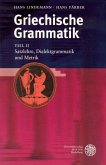Evert van Emde Boas (University of Oxford), Albert Rijksbaron (Universiteit van Amsterdam), Luuk Huitink (Universiteit Leiden)
The Cambridge Grammar of Classical Greek
Mitarbeit:Emde Boas, Evert van; Rijksbaron, Albert; Huitink, Luuk; de Bakker, Mathieu
Evert van Emde Boas (University of Oxford), Albert Rijksbaron (Universiteit van Amsterdam), Luuk Huitink (Universiteit Leiden)
The Cambridge Grammar of Classical Greek
Mitarbeit:Emde Boas, Evert van; Rijksbaron, Albert; Huitink, Luuk; de Bakker, Mathieu
- Broschiertes Buch
- Merkliste
- Auf die Merkliste
- Bewerten Bewerten
- Teilen
- Produkt teilen
- Produkterinnerung
- Produkterinnerung
This entirely new, comprehensive reference grammar of Classical Greek is aimed at students, teachers and academics. It combines traditional grammatical description with the latest insights from Greek and general linguistics, covering morphology, syntax, and textual coherence. Succinct yet full analyses are accompanied by numerous original examples.
Andere Kunden interessierten sich auch für
![Griechische Grammatik 2. Satzlehre. Dialektgrammatik und Metrik Griechische Grammatik 2. Satzlehre. Dialektgrammatik und Metrik]() Hans LindemannGriechische Grammatik 2. Satzlehre. Dialektgrammatik und Metrik22,00 €
Hans LindemannGriechische Grammatik 2. Satzlehre. Dialektgrammatik und Metrik22,00 €- Bd.2
![Griechische Grammatik Bd. 2: Syntax und syntaktische Stilistik / Handbuch der Altertumswissenschaft Abt. 2, 1/2, Tl.2 Griechische Grammatik Bd. 2: Syntax und syntaktische Stilistik / Handbuch der Altertumswissenschaft Abt. 2, 1/2, Tl.2]() Eduard SchwyzerGriechische Grammatik Bd. 2: Syntax und syntaktische Stilistik / Handbuch der Altertumswissenschaft Abt. 2, 1/2, Tl.2108,00 €
Eduard SchwyzerGriechische Grammatik Bd. 2: Syntax und syntaktische Stilistik / Handbuch der Altertumswissenschaft Abt. 2, 1/2, Tl.2108,00 € - Bd.1
![Griechische Grammatik Bd. 1: Allgemeiner Teil, Lautlehre, Wortbildung, Flexion / Handbuch der Altertumswissenschaft Abt. 2, 1/1, Tl.1 Griechische Grammatik Bd. 1: Allgemeiner Teil, Lautlehre, Wortbildung, Flexion / Handbuch der Altertumswissenschaft Abt. 2, 1/1, Tl.1]() Eduard SchwyzerGriechische Grammatik Bd. 1: Allgemeiner Teil, Lautlehre, Wortbildung, Flexion / Handbuch der Altertumswissenschaft Abt. 2, 1/1, Tl.1108,00 €
Eduard SchwyzerGriechische Grammatik Bd. 1: Allgemeiner Teil, Lautlehre, Wortbildung, Flexion / Handbuch der Altertumswissenschaft Abt. 2, 1/1, Tl.1108,00 € - Bd.4
![Griechische Grammatik Bd. 4: Stellenregister / Handbuch der Altertumswissenschaft Abt. 2, 1/4, Tl.4 Griechische Grammatik Bd. 4: Stellenregister / Handbuch der Altertumswissenschaft Abt. 2, 1/4, Tl.4]() Eduard SchwyzerGriechische Grammatik Bd. 4: Stellenregister / Handbuch der Altertumswissenschaft Abt. 2, 1/4, Tl.478,00 €
Eduard SchwyzerGriechische Grammatik Bd. 4: Stellenregister / Handbuch der Altertumswissenschaft Abt. 2, 1/4, Tl.478,00 € - Bd.3
![Griechische Grammatik Bd. 3: Register / Handbuch der Altertumswissenschaft Abt. 2, Bd.1/3, Tl.3 Griechische Grammatik Bd. 3: Register / Handbuch der Altertumswissenschaft Abt. 2, Bd.1/3, Tl.3]() Eduard SchwyzerGriechische Grammatik Bd. 3: Register / Handbuch der Altertumswissenschaft Abt. 2, Bd.1/3, Tl.384,00 €
Eduard SchwyzerGriechische Grammatik Bd. 3: Register / Handbuch der Altertumswissenschaft Abt. 2, Bd.1/3, Tl.384,00 € ![Griechische Grammatik 1. Griechische Laut- und Formenlehre Griechische Grammatik 1. Griechische Laut- und Formenlehre]() Hans ZinsmeisterGriechische Grammatik 1. Griechische Laut- und Formenlehre19,00 €
Hans ZinsmeisterGriechische Grammatik 1. Griechische Laut- und Formenlehre19,00 €![The Byzantine Grammarians The Byzantine Grammarians]() Robert H. RobinsThe Byzantine Grammarians119,99 €
Robert H. RobinsThe Byzantine Grammarians119,99 €-
-
-
This entirely new, comprehensive reference grammar of Classical Greek is aimed at students, teachers and academics. It combines traditional grammatical description with the latest insights from Greek and general linguistics, covering morphology, syntax, and textual coherence. Succinct yet full analyses are accompanied by numerous original examples.
Produktdetails
- Produktdetails
- Verlag: Cambridge University Press
- Seitenzahl: 854
- Erscheinungstermin: 21. März 2019
- Englisch
- Abmessung: 244mm x 170mm x 46mm
- Gewicht: 1680g
- ISBN-13: 9780521127295
- ISBN-10: 0521127297
- Artikelnr.: 54803530
- Herstellerkennzeichnung
- Libri GmbH
- Europaallee 1
- 36244 Bad Hersfeld
- gpsr@libri.de
- Verlag: Cambridge University Press
- Seitenzahl: 854
- Erscheinungstermin: 21. März 2019
- Englisch
- Abmessung: 244mm x 170mm x 46mm
- Gewicht: 1680g
- ISBN-13: 9780521127295
- ISBN-10: 0521127297
- Artikelnr.: 54803530
- Herstellerkennzeichnung
- Libri GmbH
- Europaallee 1
- 36244 Bad Hersfeld
- gpsr@libri.de
Evert van Emde Boas is Leventis Research Fellow at Merton College, Oxford. He has previously held teaching and research positions at four universities in the Netherlands, and at the Calleva Research Centre at Magdalen College, Oxford. He specializes in the application of modern linguistic and cognitive approaches to ancient Greek literature, and is the author of a monograph and several articles on Greek tragedy.
Preface; Abbreviations, symbols, editions; On terminology; Part I. Phonology and Morphology: 1. The signs and sounds of Classical Greek; 2. Introduction to nominal forms; 3. The article; 4. Nouns; 5. Adjectives and participles; 6. Adverbs; 7. Pronouns; 8. Correlative pronouns and adverbs; 9. Numerals; 10. The dual: nominal forms; 11. Introduction to verb forms; 12. The present; 13. The aorist: active and middle; 14. The aorist: passive; 15. The future: active and middle; 16. The future: passive; 17. The perfect (and future perfect): introduction; 18. The perfect: active; 19. The perfect: middle-passive; 20. The future perfect; 21. The dual: verb forms; 22. Principal parts; 23. Word formation; 24. Accentuation; 25. Ionic and other dialects; Part II. Syntax: 26. Introduction to simple sentences; 27. Agreement; 28. The article; 29. Pronouns and quantifiers; 30. Cases; 31. Prepositions; 32. Comparison; 33. The verb: tense and aspect; 34. The verb: mood; 35. The verb: voice; 36. Impersonal constructions; 37. Verbal adjectives; 38. Questions, directives, wishes, exclamations; 39. Introduction to complex sentences; 40. Introduction to finite subordinate clauses; 41. Indirect statements; 42. Indirect questions and indirect exclamations; 43. Fear clauses; 44. Effort clauses; 45. Purpose clauses; 46. Result clauses; 47. Temporal clauses; 48. Causal clauses; 49. Conditional clauses; 50. Relative clauses; 51. The infinitive; 52. The participle; 53. Overview of subordinate constructions; 54. Overview of moods; 55. Overview of the uses of ni; 56. Overview of negatives; 57. Overview of the uses of ; Part III. Textual Coherence: 58. Introduction; 59. Particles; 60. Word order; 61. Four sample passages; Bibliography; Indexes.
Preface; Abbreviations, symbols, editions; On terminology; Part I. Phonology and Morphology: 1. The signs and sounds of Classical Greek; 2. Introduction to nominal forms; 3. The article; 4. Nouns; 5. Adjectives and participles; 6. Adverbs; 7. Pronouns; 8. Correlative pronouns and adverbs; 9. Numerals; 10. The dual: nominal forms; 11. Introduction to verb forms; 12. The present; 13. The aorist: active and middle; 14. The aorist: passive; 15. The future: active and middle; 16. The future: passive; 17. The perfect (and future perfect): introduction; 18. The perfect: active; 19. The perfect: middle-passive; 20. The future perfect; 21. The dual: verb forms; 22. Principal parts; 23. Word formation; 24. Accentuation; 25. Ionic and other dialects; Part II. Syntax: 26. Introduction to simple sentences; 27. Agreement; 28. The article; 29. Pronouns and quantifiers; 30. Cases; 31. Prepositions; 32. Comparison; 33. The verb: tense and aspect; 34. The verb: mood; 35. The verb: voice; 36. Impersonal constructions; 37. Verbal adjectives; 38. Questions, directives, wishes, exclamations; 39. Introduction to complex sentences; 40. Introduction to finite subordinate clauses; 41. Indirect statements; 42. Indirect questions and indirect exclamations; 43. Fear clauses; 44. Effort clauses; 45. Purpose clauses; 46. Result clauses; 47. Temporal clauses; 48. Causal clauses; 49. Conditional clauses; 50. Relative clauses; 51. The infinitive; 52. The participle; 53. Overview of subordinate constructions; 54. Overview of moods; 55. Overview of the uses of ni; 56. Overview of negatives; 57. Overview of the uses of ; Part III. Textual Coherence: 58. Introduction; 59. Particles; 60. Word order; 61. Four sample passages; Bibliography; Indexes.








